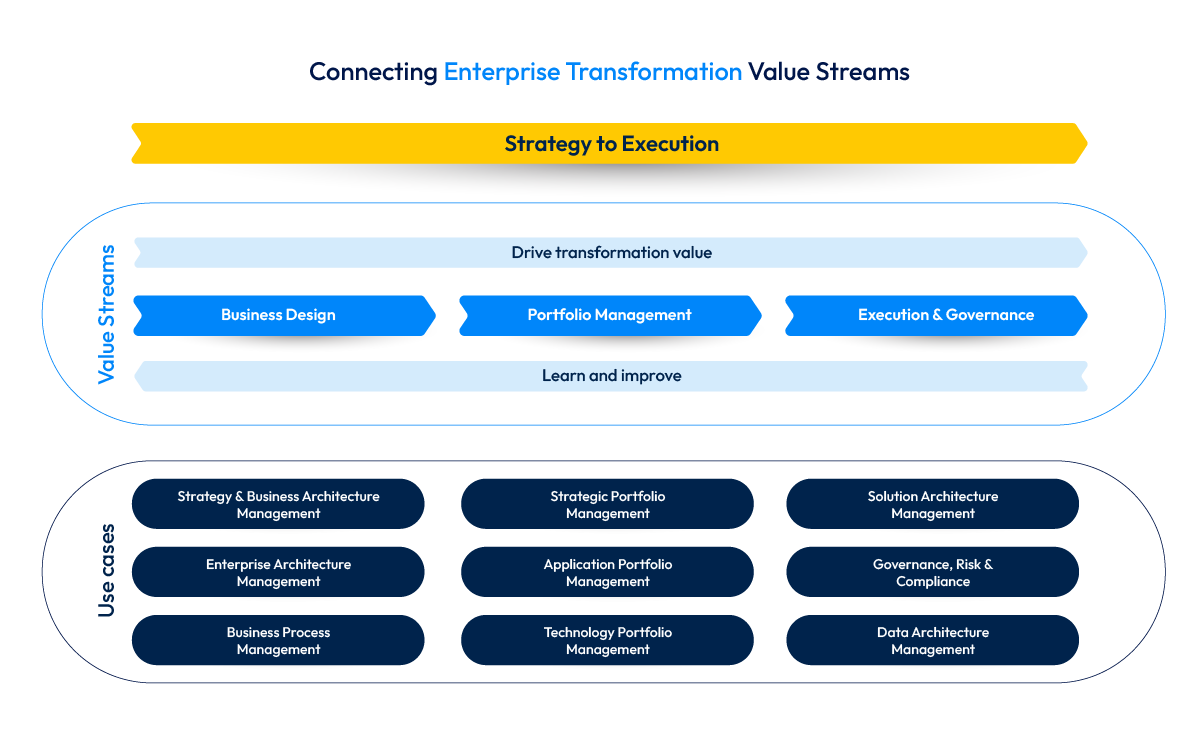Digitalization and the Need for Speed

Many organizations are prioritizing a robust digital strategy that emphasizes agility and technological acceleration. The speed of digital innovation enables businesses to streamline operations and adopt digital solutions that enhance efficiency. As companies move toward digital maturity, they are challenged to achieve digital transformation while scaling their initiatives effectively.
As companies progress toward digital maturity, they face the challenge of driving transformation while effectively scaling their initiatives.
In a previous blog article on the the evolution of EA in business transformation we explored how business leaders face a wickedly complex challenge: responding to frequent, high-impact business threats and opportunities while managing an IT landscape that inevitably becomes more complex due to digitalization.
Adding to this complexity, leaders are pressured to move faster than ever without compromising compliance, security, or governance.
The Pressure to Accelerate
To illustrate, a senior IT leader I recently spoke with outlined ambitious transformation goals:
10x faster rollout of new solutions (a 90% reduction in elapsed time).
4x productivity improvement (delivering 4x more with the same resources).
These targets are not aspirational; they’re part of a board-mandated directive to radically reshape the organization’s operations, including transforming the transformation process itself.
This pressure to accelerate is not unique. Across industries, digital leaders face similar expectations, driven by competitive pressure, shifting customer expectations, and the constant pace of technological change.
The cost of delay is high: slower time to market, lost revenue opportunities, and the risk of being outpaced by more agile competitors.
So, what enables this acceleration?
At the core of this transformation are two key forces: digitalization and artificial intelligence (AI). Together, they offer the potential to break down silos, automate decision-making, and move from strategy to execution at unprecedented speed.
Enabling a Digital Backbone
Realizing true digital transformation requires more than technology upgrades, it demands a strong digital backbone: a connected, enterprise-wide foundation that fuels agility, innovation, and scalable growth.
This vision is grounded in three enterprise-wide priorities:
- Integrated data management enabled by a core set of enterprise platforms.
- Rapid delivery and evolution of customer-centric digital products.
- Aligned enterprise capabilities that deliver a seamless and consistent customer experience.
This approach reflects Gartner’s concept of Composable Capabilities, empowering enterprises to become more modular, adaptive, and resilient.
However, building this enterprise backbone requires more than vision it calls for a connected, end-to-end operating model that links:
- Strategic ideas to executable outcomes, accelerating time to value.
- Enterprise stakeholders across business and IT, fostering true collaboration.
- Automation and interoperability, integrated across the entire enterprise transformation lifecycle from strategy to delivery.
Critically, enterprise-wide visibility into portfolio initiatives, capabilities, applications, and data is essential. It ensures alignment, reduces redundancy and helps uncover risks early in the transformation process.
Foundational Enablers for Transformation
Successful enterprise transformation relies on a strong foundation of tools, insights, and collaboration. One key enabler is a centralized, enterprise-wide repository that is accessible to all relevant stakeholders.

Key enablers include:
A centralized repository is accessible to all users, providing:
- Strategic context that connects initiatives to business goals and priorities.
- Visibility into both existing and planned enterprise capabilities.
- Insights into the impact of change across customers, teams, and the IT landscape.
In addition, AI-powered insights help accelerate decision-making by:
- Visibility into both existing and planned enterprise capabilities.
- Insights into the impact of change across customers, teams, and the IT landscape.
- Identifying existing assets, data quality gaps, standards, and active initiatives.
- Allowing enterprise architects to focus on high-value advisory work instead of manual data gathering.
Architects and AI: Partners in Speed
Architects thrive in adding value where trade-offs and constraints, speed, cost, value, and risk are at play. AI augments this expertise by:
Together, architects and AI make a powerful team:
- AI brings together goals, requirements, standards, and patterns to suggest smart starting points for solution design.
- It adjusts those designs quickly as things change—without starting from scratch.
- It even helps engineers generate code, speeding up delivery through DevOps pipelines.
This isn’t a future vision; it’s happening now.
Closing the Strategy-to-Execution Gap
At BizzDesign, we tackle the strategy-to-execution gap with a robust framework. This approach enables:
- Accelerate transformation efforts dramatically, boosting both speed and productivity across the value chain.
- Connect the dots across key activities, enabling more integrated, enterprise-wide improvement.
- By bridging vision and execution, we help turn strategy into measurable outcomes faster and more confidently.
Let’s Transform Together
We’re at a pivotal moment, an opportunity to rethink how transformation happens and what it can achieve.
At Bizzdesign, we’re here to be more than just a vendor; we aim to be your trusted partner in building a stronger, more agile enterprise.
We aim to be the leading partner, providing:
- Deep expertise, practical resources, and a global footprint.
- An independent, objective perspective that can be relied upon.
- The most comprehensive end-to-end enterprise transformation platform to help turn strategy into lasting results.
The future of transformation is already unfolding.
Let’s shape it together.
Stay tuned for future blogs to share the capabilities we’re bringing to the market to make this a reality.


